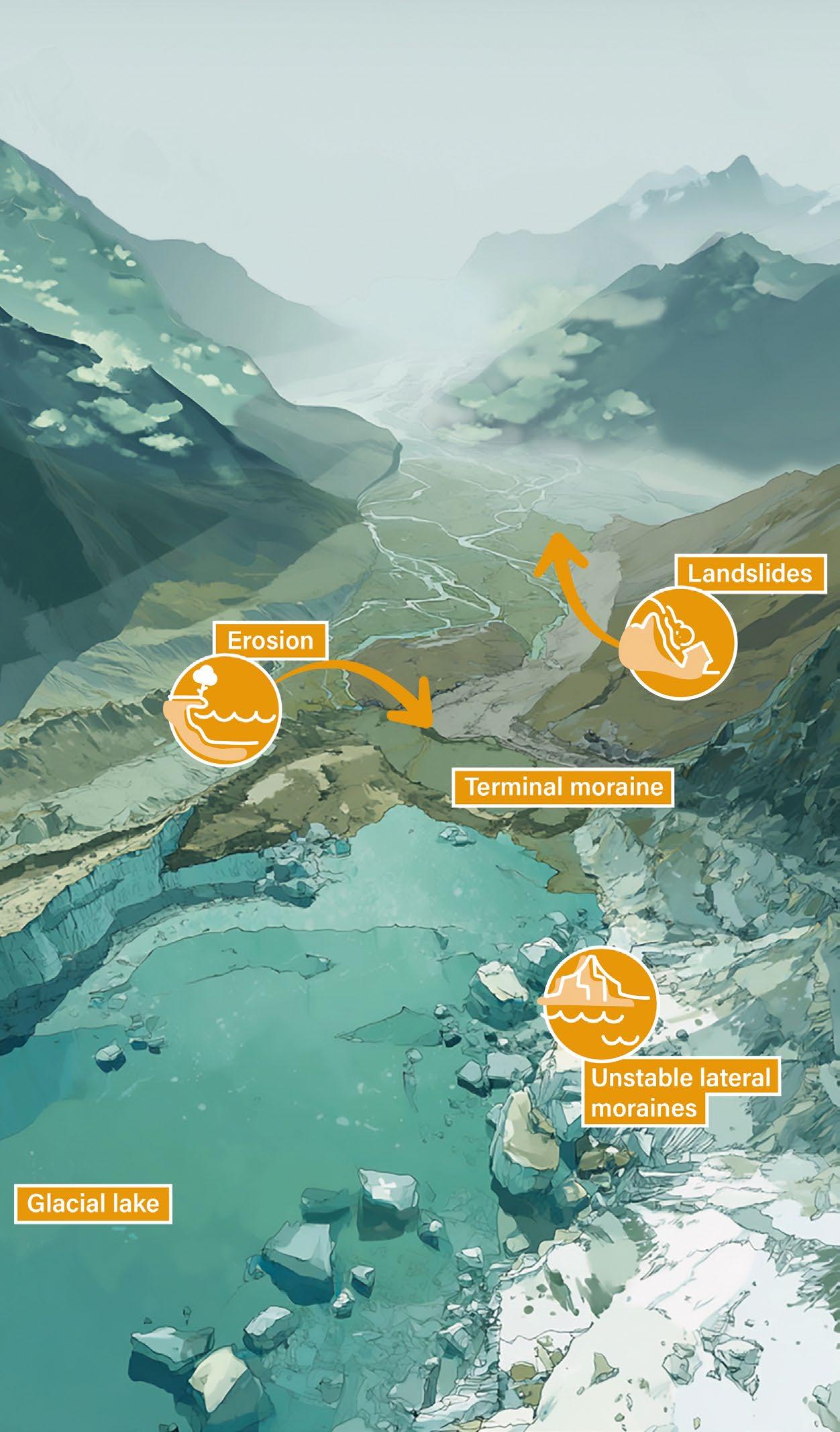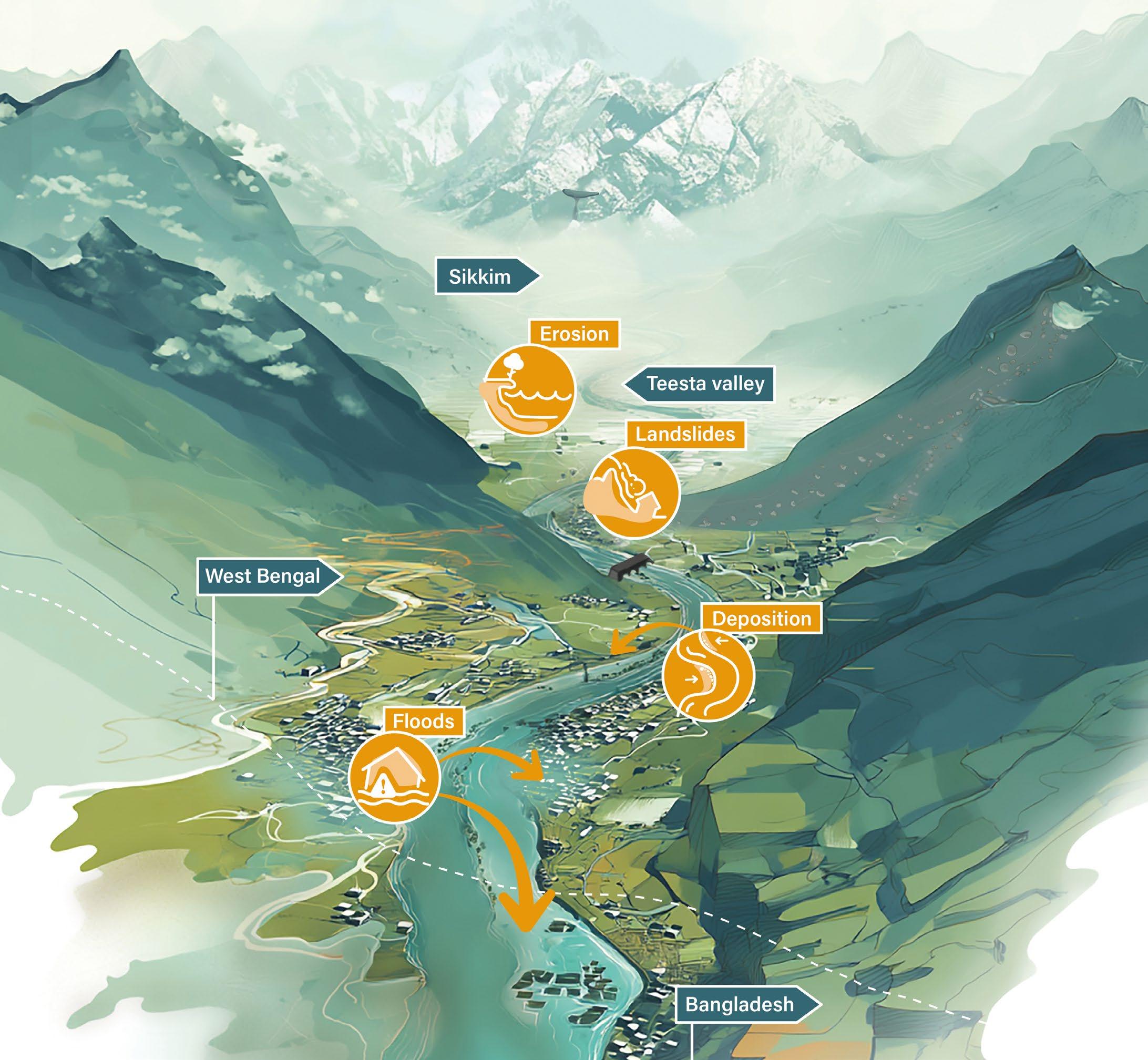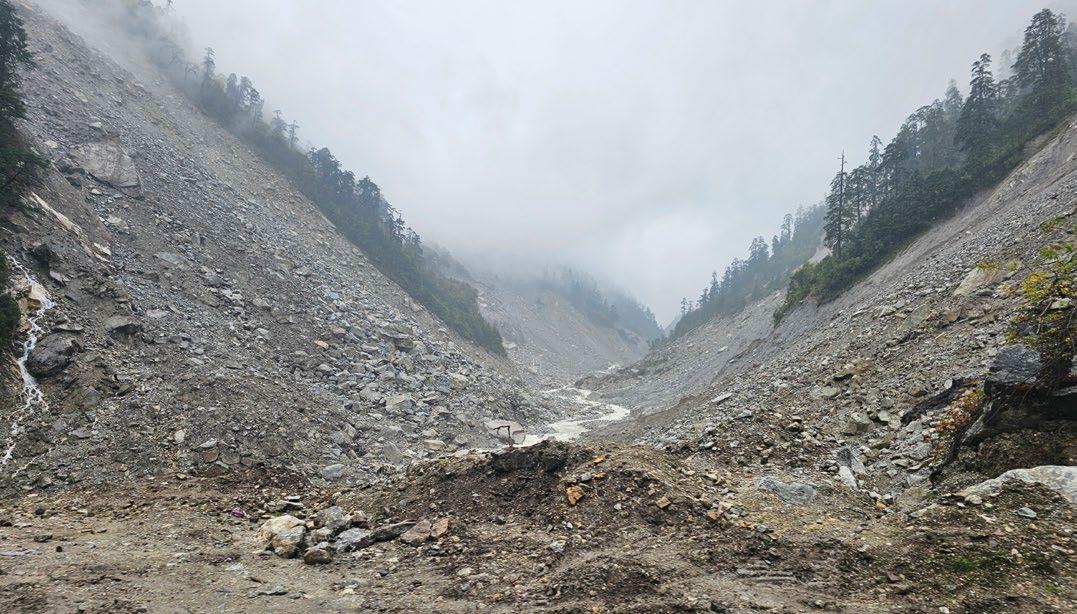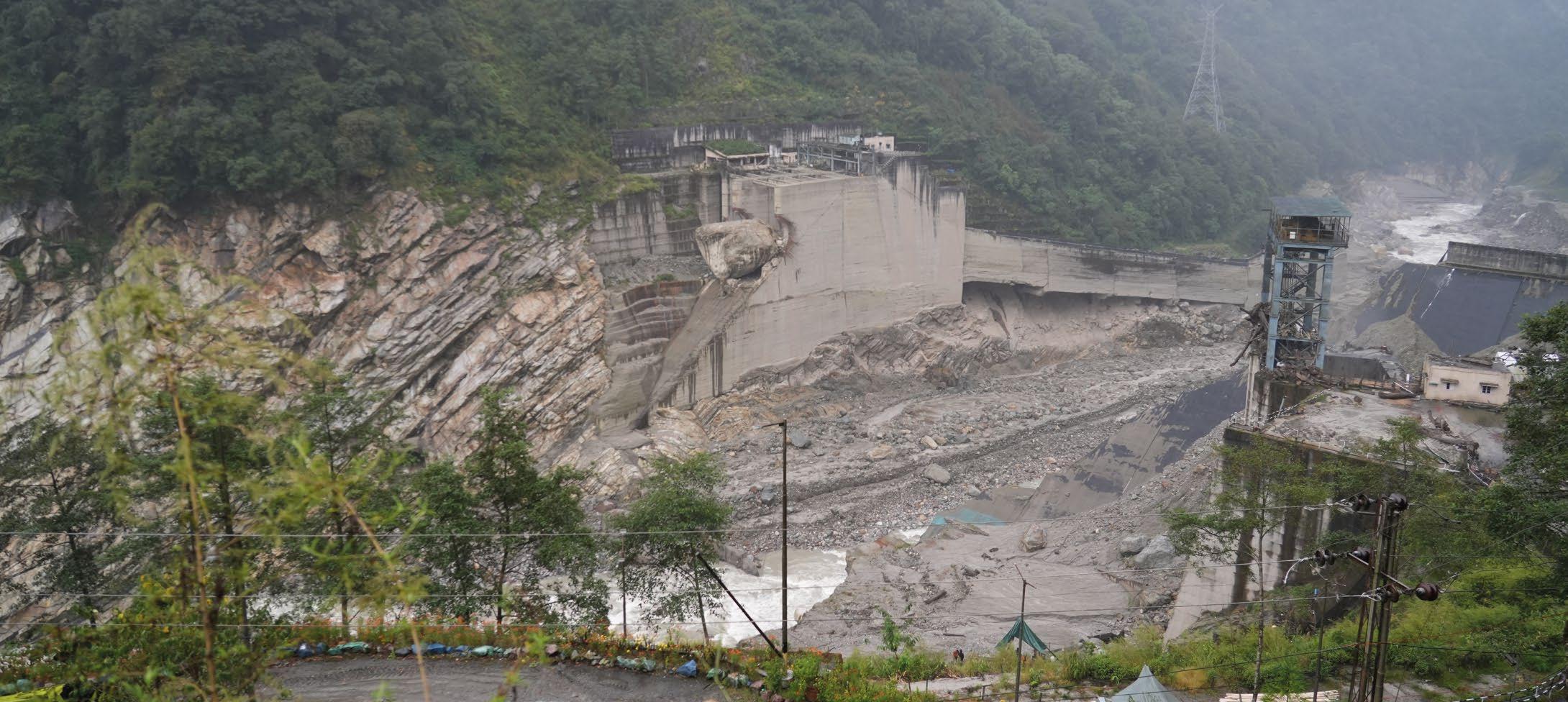The 2023 South Lhonak Glacial Lake Outburst Flood: Insights, lessons
and recommendations
The 2023 Glacial Lake Outburst Flood (GLOF) from South Lhonak Lake in Sikkim, India, offers key lessons and insights for understanding and managing GLOFs and related hazards and impacts in high mountain regions. While the destruction was immense, the relatively low number of casualties highlights the effectiveness of early warning and emergency preparedness. At the same time, the event reveals deficiencies in current hazard assessments, especially regarding sediment dynamics and unstable lateral moraines. With climate change exacerbating future risks, the case underscores the urgent need for more comprehensive risk assessments, improved monitoring, and robust disaster risk reduction measures. This brief summarises four key lessons and insights.
1. Lateral moraine stability is a critical — and often overlooked — potential GLOF trigger that hazard assessments and early warning systems should consider
The partial collapse of the northern lateral moraine at South Lhonak Lake caused a high displacement wave that in turn caused the lake to breach the terminal moraine. Lateral moraines – particularly when destabilised by glacial retreat and permafrost degradation – pose a major but under-recognised potential to trigger GLOFs. Prior to the GLOF event, the thawing of permafrost and an influx of meltwater from nearby North Lhonak Lake reduced the stability of the landslide area. The hazard assessment did not adequately consider such process chains.
Recommendations:
• Hazard assessments should include potentially unstable lateral moraines as possible triggers of major GLOFs.
• Hazard assessments should be more comprehensive, and should consider adjacent glacial lakes.
• Glacial lake monitoring should include observations of the lateral slopes. Such observations might be supported by repeated satellite-based radar interferometry (InSAR), a technology that can reliably detect small displacements based on remotely sensed radar imagery.
Glacial Lake Outburst Flood triggers and local impacts (Illustration produced by Zoï Environment Network, 2025)
What Happened
On the night of 3 October 2023, a massive slope collapse from the northern lateral moraine of South Lhonak Lake in Sikkim, India, triggered a catastrophic chain of events. A 14.7 million m³ landslide plunged into the lake, generating a tsunami wave 20 metres high. This wave overtopped and breached the frozen frontal moraine that forms the natural dam of this lake, causing the sudden drainage of approximately 50 million m³ of water. The landslide material could fill the entire Narendra Modi Stadium in Ahmedabad up to the roof nearly twice. The 50 million m3 of water bursting from the lake would fill about 20,000 Olympic swimming pools — enough to stretch from Delhi to Mumbai if placed end-to-end.
The resulting GLOF surged through the Teesta Valley, causing massive destruction. On the first 67 km of the trajectory – between South Lhonak Lake and Chungthang – the GLOF…
… triggered 45 secondary landslides
… caused extensive erosion of riverbanks, mobilising approximately 270 million m³ of sediment
… covered the distance in about 2 hours and 20 minutes in an average flow velocity of almost 30 km/h
… destroyed the 1,200-MW Teesta III hydropower dam at Chungthang
Downstream impacts of the Glacial
Flood in the
India (Illustration produced by Zoï Environment Network, 2025)
Lake Outburst
Teesta Valley,
Contemporary numerical mass movement models, while useful for assessing hazards and risks of glacial lakes, tend to underestimate the potential volume of downstream erosion, so hazard maps may underestimate the actual threat to lives and infrastructure. The South Lhonak GLOF mobilised a sediment volume more than five times the initial lake outburst volume. Numerical models generally account for bed erosion but often neglect lateral erosion of riverbanks. In this event, however, lateral landslides played a significant role in contributing to the overall sediment volume. Further clarity is needed on how, and to what extent, such effects of lateral erosion can be incorporated into numerical modelling. The Teesta III hydropower dam at Chungthang was designed for extreme water flood discharges, but floods with debris-flow characteristics, including high sediment content, were not explicitly addressed in its design.
Recommendations:
• Risk assessments and infrastructure planning should account for the amplifying effects of downstream sediment entrainment on floods.
• Design considerations for future dams should include loads generated by sediment-rich floods, and the safety of existing dams should be reassessed accordingly.
Zemu Valley above Lachen before (left) and after (right) the GLOF (Photos: GEOTEST, 2023 and 2024)
Destroyed Teesta III hydropower dam at Chungthang (Photo: GEOTEST, 2024)
2. Erosion processes should be more thoroughly considered in hazard assessments
Despite the massive destruction – about 25,900 buildings damaged or destroyed, numerous bridges lost, and extensive impacts on roads and farmland – the human toll was disproportionately low, with at least 92 deaths reported by Reuters. This outcome reflects the value of timely information dissemination and effective emergency response, in this case enabled by the Indo-Tibetan Border Police stationed upstream in the river basin.
Recommendations:
• The emergency protocols, alarm infrastructure and disaster preparedness that played a critical life-saving role should be further developed.
• Future efforts on early warning for GLOFs and other processes should analyse, improve, and build on existing local communication and knowledge systems, enhanced with mock drills and awareness-raising about new threats.
The disaster did not neutralise the threat of future outburst floods, and the situation at South Lhonak Lake remains critical for the Teesta valley. The northern lateral moraine continues to deform, with high post-event movement rates. Additionally, formerly buried dead ice at the outlet channel of the lake is now exposed to melting, and will modify the structure and geometry of the outlet with potentially negative consequences on lake stability. Along the flood trajectory, several slopes that were destabilised by the erosion during the 2023 GLOF remain unstable and show continued deformation. Many similar situations exist at other lakes that do not completely drain and continue to expand.
Recommendations:
• Monitoring stations should be complemented by analyses of satellite-based radar data.
• Early warning efforts should cover as many glacial lakes as possible while providing multi-hazard capabilities to detect floods or mass movements coming down the valley regardless of the origin.
• Structural mitigation measures such as lake lowering and retention structures should be adequately planned.
• Local capacity-building should focus on developing skills in GLOF risk management and experience-sharing with other Himalayan states. 3. Timely warnings
Understanding a multi-hazard cascade in the Sikkim Himalaya
The Swiss Agency for Development and Cooperation India supports climate change adaptation in the mountain states of the Indian Himalayan Region through the Strengthening Climate Change Adaptation in Himalayas project. Demonstrating a model approach to GLOF risk management – from scientific assessments to the design of an early warning system – is a key initiative under this project. The initiative is being implemented by a consortium including Geotest, the University of Zurich, the University of Geneva and Geopraevent, in close partnership with state authorities and experts.
Imprint
This Scientific Brief is produced by University of Zurich, Geotest and Zoï Environment Network based on The Sikkim flood of October 2023: Drivers, causes, and impacts of a multi-hazard cascade (Sattar et al., 2025).
4. GLOF hazards may remain high after an event






